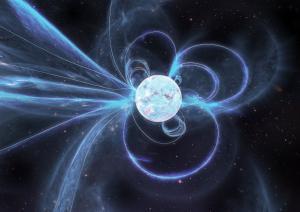Blog
A Magnetic Age
29 September 2021
 Carl Knox/ OzGrav
Carl Knox/ OzGravIn a few billion years the Sun will end its life as a white dwarf. As the Sun runs out of hydrogen to fuse for energy it will collapse under its own weight. Gravity will compress the Sun until it’s roughly the size of Earth, at which point a bit of quantum physics will kick in. Electrons from the Sun’s atoms will push back against gravity, creating what is known as degeneracy pressure. Once a star reaches this state it will cool over time, and the once brilliant star will eventually fade into the dark.
Most stars in the universe will end as a white dwarf. Only the largest stars will explode as supernovae and become neutron stars or black holes. There are lots of white dwarfs in the Milky Way, but many of them can be difficult to study.
 Giuseppe Parisi
Giuseppe ParisiFor one thing, white dwarfs don’t produce energy in their cores as regular stars do. They cool and fade as they age, so we tend to see the youngest and brightest white dwarfs. Observations of white dwarfs are also biased toward those with the smallest mass. That’s because the more massive a white dwarf is, the smaller it is. The reason for this has to do with the balance between electron degeneracy pressure and gravity. In a white dwarf, the electrons act as a sort of quantum gas. The more massive the white dwarf, the more tightly its gravity can squeeze the electrons, hence a smaller volume.
Fortunately, we’re getting better at studying smaller and cooler white dwarfs, as a recent study shows.1 The team used data from the Gaia spacecraft to find white dwarfs within 20 parsecs of Earth. In addition to known white dwarfs, the team identified about 100 white dwarfs that had never been cataloged. They then looked at the spectrum of these white dwarfs using ISIS spectrograph and polarimeter on the William Herschel Telescope. Since the spectrum of a white dwarf is affected by its magnetic field, the team was able to measure the strength of their magnetic fields.
They found an interesting result. There is a correlation between the age of a white dwarf and its magnetic field. The older a white dwarf is, the more likely it has a strong magnetic field. In other words, white dwarfs tend to become more magnetic as they age. This suggests that white dwarf magnetic fields are created through the cooling process of the star.
We aren’t sure how the cooling process magnetizes white dwarfs. The magnetic fields of larger and younger white dwarfs might be explained by a dynamo mechanism, similar to the process that generates Earth’s magnetic field. But the magnetic fields of old white dwarfs are often much larger than we think can be produced by a dynamo. So something strange is going on, and it will take more research to solve this mystery.
Bagnulo, S., and J. D. Landstreet. “New insight into the magnetism of degenerate stars from the analysis of a volume limited sample of white dwarfs.” arXiv preprint arXiv:2106.11109 (2021). ↩︎